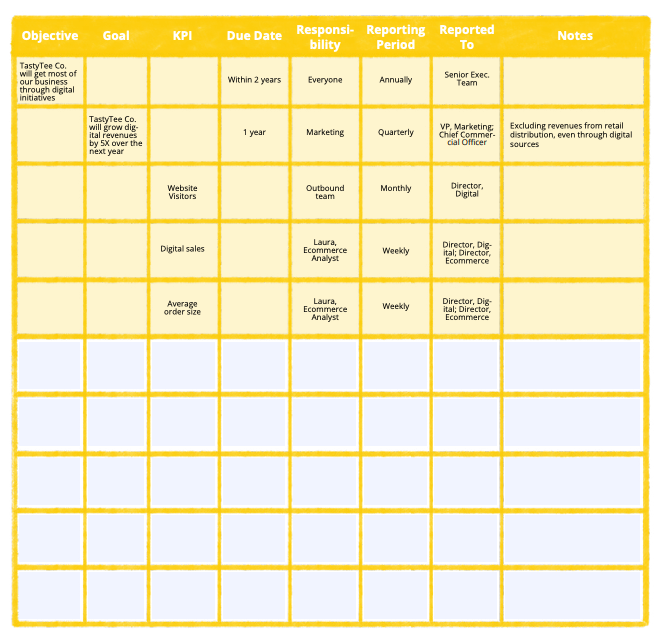It’s hard to hit a target you aren’t aiming for, so having goals for your digital transformation is a must. Having strong goals is even better. Not only will goals and key performance indicators (KPIs) help guide your progress, but they’ll help you evaluate initiatives and campaigns and allow you to make informed adjustments where needed. As you read through this, think about how your ideas can be tracked, measured, and reported.
Objectives, Goals, KPIs, and Reporting
What are your overall objectives for your digital transformation? An objective is a long-term desired outcome, usually written in plain language, that imagines what your ideal end-state looks like. A good objective can be tied to metrics, but doesn’t need to be — this is your opportunity to paint big ideas with a broad brush. A good example of an objective is, “In two years, our brand will get most of our business through digital initiatives.”
SMART Goals framework
Once you have some objectives, you need to create goals to support them. Unlike an objective, a goal has definitive success criteria. We tend to reference the SMART Goals framework, in which a goal is:
- Specific: The goal should clearly address why it exists, when it needs to be accomplished, what you’re trying to accomplish, and who is responsible.
- Measurable: The goal should be quantifiable and linked to concrete metrics, and ideally supported by one or more KPIs.
- Achievable: The goal should push you to do better while still being realistically doable. Goals that aren’t achievable will only serve to demotivate.
- Relevant: The goal should be tied to a larger objective, and readers should be able to clearly see how it supports the company as a whole.
- Time-bound: The goal should have a clear and well-defined time frame, including when the goal takes effect and when it needs to be completed.
Each goal, in turn, should have at least one key performance indicator associated with it.
What are key performance indicators?
Key performance indicators are a quantifiable value of how effective a specific tactic, action, or initiative is at achieving a business objective. These are what you will regularly monitor and report, and will be the pulse check of how progress towards your goals and objectives are going.
There are many different types of KPIs that marketers can track, but here are a few popular examples that marketers have used to measure the success of their efforts:
- Cart Abandonment Rate (CAR): This KPI is an indicator of how many website visitors leave your site before completing the checkout process and it’s a great way to see if the experience on your website is turning off customers. For example, things like slow load times, a tedious checkout process, expensive shipping, or limited payment options can cause a high cart abandonment rate. Marketers can calculate their CAR with this formula:
- 1 - [(amount of purchases)/(amount shopping carts with at least one item) x 100]
- Conversion Rate: This KPI is the number of people that completed the desired action divided by the total size of the audience you engage with. For example, the desired action can be anything from signing up for a free trial to completing a purchase to creating a new account. By calculating this, marketers can see the effectiveness of their total marketing efforts, including overall messaging, content, website experience, and more.
- Return on Ad Spend (ROAS): This KPI is exactly what it sounds like: it's how much revenue is made for every dollar spent on advertising online. A negative ROAS might be an indicator that certain factors of your marketing initiatives, such as channels, ad creative, messaging, and content, may need to change. A positive ROAS does the opposite by indicating the efforts that marketers should double down on.
- Customer Retention Rate: This KPI identifies how many customers a brand retains over a specific period of time. Customer retention rates are great at diagnosing the long-term health of a business and indicate whether there are things within an organization that need to change. This may include things like customer service, antiquated offerings and products, and price points. Marketers can calculate customer retention rates with this equation:
- [(amount of customer at the end of a time period - amount of new customers the time period)/amount of customers at the beginning of time period] X 100
Final Thoughts
In addition to setting goals and objectives, you will also want to note the reporting period for each step and who it will be reported to. Remember that unless you have a very small team, not everyone will need to know every single KPI, so try to make sure that every report is relevant and meaningful.
Click the image below to download this checklist. ![]()
Last updated on December 2nd, 2022.
